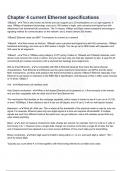Exam (elaborations)
Chapter 4 current Ethernet specifications Questions with 100% Correct Answers Graded A+ | Verified | Latest Update 2024, Actual Complete Solutions ,Garanteed Distinction
- Course
- Institution
Chapter 4 current Ethernet specifications Questions with 100% Correct Answers Graded A+ | Verified | Latest Update 2024, Actual Complete Solutions ,Garanteed Distinction
[Show more]



